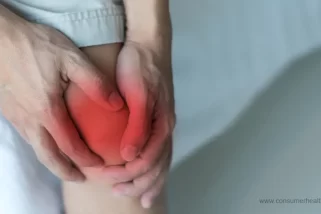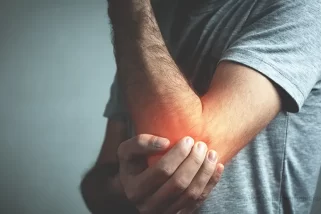Introduction
Joint pain affects millions worldwide, significantly impacting daily activities and overall well-being. Understanding its nuances is crucial for effective management and improved quality of life. With the right knowledge and tools, individuals can mitigate the debilitating effects of joint pain, leading to a healthier and more active lifestyle. In this guide, we will cover the different types of joint pain, common causes, and effective management strategies.

Types of Joint Pain
Joint pain, a common discomfort affecting individuals of various ages, can stem from multiple sources, each requiring a considered approach for effective management. Below are the primary types:
- Osteoarthritis (OA): Characterized by the degradation of cartilage within the joint, leading to pain, stiffness, and reduced mobility. By studies [1], OA is the most prevalent form of arthritis, particularly impacting older adults.
- Rheumatoid Arthritis (RA): An autoimmune condition that causes the immune system to attack the lining of the joints, leading to inflammation, pain, and potentially long-term damage to joint integrity.
- Gout: Caused by the buildup of uric acid crystals in a joint, leading to severe pain, redness, and swelling, often affecting the big toe.
- Fibromyalgia: A condition marked by widespread musculoskeletal pain accompanied by fatigue, sleep, memory, and mood issues, impacting the way the brain processes pain signals.
- Bursitis: Inflammation of the bursae, the small, fluid-filled sacs that cushion the bones, tendons, and muscles near joints, often caused by repetitive movements or pressure on the joint.
- Tendinitis: Inflammation or irritation of a tendon, the thick fibrous cords that attach muscle to bone. This condition is commonly the result of overuse or aging.
Common Causes of Joint Pain
- 1. Arthritis: Osteoarthritis and rheumatoid arthritis are predominant, affecting millions globally with varying degrees of pain and disability. Osteoarthritis, the most common form, results from the gradual breakdown of cartilage in joints, leading to pain and stiffness. In research [2] Rheumatoid arthritis, an autoimmune disorder, causes inflammation in the lining of joints, resulting in pain, swelling, and deformity over time.
- 2. Injury: From sports accidents to falls, trauma can lead to both acute and chronic joint issues. Sprains, strains, and fractures can damage ligaments, tendons, and cartilage, resulting in joint instability, limited range of motion, and chronic pain if left untreated.
- 3. Age-Related Wear and Tear: Natural degeneration of joint tissues occurs with age, exacerbating vulnerability to pain. As individuals age, cartilage loses elasticity and thins, bones become less dense, and synovial fluid production decreases, leading to increased friction, inflammation, and discomfort in the joints.
- 4. Autoimmune Diseases: Conditions like lupus challenge the body's immune response, affecting joint health. In autoimmune diseases, the immune system mistakenly attacks healthy tissues, including those in the joints, leading to inflammation, pain, and potential joint damage if not managed properly.
- 5. Lifestyle Factors: Poor diet, lack of exercise, and obesity are proven contributors to deteriorating joint function. A diet high in processed foods, saturated fats, and sugar can contribute to inflammation and exacerbate joint pain. Sedentary lifestyles weaken muscles surrounding joints, leading to instability and increased susceptibility to injury. Obesity adds extra stress to weight-bearing joints, accelerating wear and tear and increasing the risk of conditions like osteoarthritis.
Managing Joint Pain
When it comes to managing joint and muscle pain, Dr. Youstina Atalla, Certified Orthopedic Clinical Specialist, recommends a multifaceted approach that combines home remedies, lifestyle modifications, and professional interventions. In addition to rest, ice or heat therapy, and over-the-counter pain medications, she emphasizes the importance of strengthening exercises and stretching routines. Strengthening muscles around the affected joint can provide support and stability, while stretching exercises can improve flexibility and range of motion.
Medical Interventions
- Physical Therapy: Enhances flexibility and strengthens muscles around joints, mitigating pain.
- Medications: Anti-inflammatory drugs and pain relievers can significantly reduce symptoms.
- Lifestyle Modifications: Weight management and diet changes can decrease joint stress and improve symptoms.
Surgical Options
- Joint Replacement Surgery: Advanced techniques in knee and hip replacements offer high success rates, improving mobility and quality of life.
- Minimally Invasive Procedures: Reduced recovery times and minimal post-operative pain, thanks to the latest surgical innovations.
- Positive Outcomes: Studies indicate those who undergo surgery experience a substantial decrease in pain and enhancement in daily activities.
Physical Therapy and Exercise:

Doctor Consulting Patient. Shutterstock Image
Engaging in guided physical therapy and low-impact exercises supports joint function and alleviates pain, with research underscoring the benefits of regular movement. [3]
Lifestyle Adjustments:
- Dietary Changes: Incorporating anti-inflammatory foods and nutrients supports overall joint health.
- Weight Management: Reducing body weight minimizes stress on joints, significantly lowering pain levels.
Alternative and Complementary Therapies:
Practices like acupuncture and yoga offer non-traditional avenues for pain relief and mobility improvement, backed by growing empirical support.
Prevention Strategies
To safeguard joint health and prevent injury, incorporating regular physical activity is essential. This not only strengthens the muscles surrounding your joints, enhancing stability and alignment, but also aids in maintaining optimal weight, thereby lessening the load on weight-bearing joints and reducing osteoarthritis risks.
A diverse exercise regimen that includes strength training, aerobic activities, and flexibility exercises offers comprehensive joint support. Equally crucial is adhering to a diet rich in anti-inflammatory foods such as fatty fish, flaxseeds, and walnuts, which combat inflammation and support tissue repair.
Regular Physical Activity:

Regular Physical Activity for Joint Pain. Shutterstock Image
- Strengthening muscles around joints shields against injury and degeneration by improving joint stability and promoting proper alignment.
- Engaging in regular physical activity also helps maintain healthy weight levels, reducing the burden on weight-bearing joints and minimizing the risk of conditions like osteoarthritis.
- Incorporating a variety of exercises, including strength training, aerobic activities, and flexibility exercises, ensures comprehensive joint support and overall physical fitness.
Healthy Eating:
- A balanced diet rich in anti-inflammatory components fosters robust joint health by reducing inflammation and supporting tissue repair.
- Foods high in omega-3 fatty acids, [4]such as fatty fish, flaxseeds, and walnuts, possess potent anti-inflammatory properties and can help alleviate joint pain and stiffness.
- Incorporating plenty of fruits, vegetables, whole grains, lean proteins, and healthy fats provides essential nutrients and antioxidants that promote joint function and overall well-being.
Proper Body Mechanics:
- Utilizing correct posture and lifting techniques prevents unnecessary joint strain and reduces the risk of musculoskeletal injuries.
- Maintaining a neutral spine position, distributing weight evenly, and avoiding prolonged periods of static posture help alleviate stress on the spine and joints.
- Implementing ergonomic adjustments in work environments and daily activities, such as using supportive footwear, ergonomic chairs, and lifting aids, enhances joint protection and minimizes the risk of repetitive strain injuries.
Conclusion
Grasping the complexities behind joint pain and its management empowers individuals to take control of their health. Through a combination of medical treatments, physical therapy, lifestyle changes, and proactive prevention, it's possible to minimize the impact of joint pain. By doing so, people can enjoy a heightened quality of life, characterized by increased activity and reduced discomfort.
4 Sources
We review published medical research in respected scientific journals to arrive at our conclusions about a product or health topic. This ensures the highest standard of scientific accuracy.
[2] Mohammed A, Alshamarri T, Adeyeye T, Lazariu V, McNutt LA, Carpenter DO. A comparison of risk factors for osteo- and rheumatoid arthritis using NHANES data. Prev Med Rep. 2020 Nov 5;20:101242. doi: 10.1016/j.pmedr.2020.101242. PMID: 33294313; PMCID: PMC7689317.
[3] Cooney JK, Law RJ, Matschke V, Lemmey AB, Moore JP, Ahmad Y, Jones JG, Maddison P, Thom JM. Benefits of exercise in rheumatoid arthritis. J Aging Res. 2011 Feb 13;2011:681640. doi: 10.4061/2011/681640. PMID: 21403833; PMCID: PMC3042669.
[4] Zivkovic AM, Telis N, German JB, Hammock BD. Dietary omega-3 fatty acids aid in the modulation of inflammation and metabolic health. Calif Agric (Berkeley). 2011 Jul;65(3):106-111. doi: 10.3733/ca.v065n03p106. PMID: 24860193; PMCID: PMC4030645.







 This article changed my life!
This article changed my life! This article was informative.
This article was informative. I have a medical question.
I have a medical question.
 This article contains incorrect information.
This article contains incorrect information. This article doesn’t have the information I’m looking for.
This article doesn’t have the information I’m looking for.